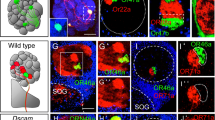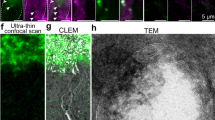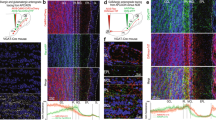Abstract
Olfactory systems utilize discrete neural pathways to process and integrate odorant information. In Drosophila, axons of first-order olfactory receptor neurons (ORNs) and dendrites of second-order projection neurons (PNs) form class-specific synaptic connections at ∼50 glomeruli. The mechanisms underlying PN dendrite targeting to distinct glomeruli in a three-dimensional discrete neural map are unclear. We found that the leucine-rich repeat (LRR) transmembrane protein Capricious (Caps) was differentially expressed in different classes of PNs. Loss-of-function and gain-of-function studies indicated that Caps instructs the segregation of Caps-positive and Caps-negative PN dendrites to discrete glomerular targets. Moreover, Caps-mediated PN dendrite targeting was independent of presynaptic ORNs and did not involve homophilic interactions. The closely related protein Tartan was partially redundant with Caps. These LRR proteins are probably part of a combinatorial cell-surface code that instructs discrete olfactory map formation.
This is a preview of subscription content, access via your institution
Access options
Subscribe to this journal
Receive 12 print issues and online access
$209.00 per year
only $17.42 per issue
Buy this article
- Purchase on Springer Link
- Instant access to full article PDF
Prices may be subject to local taxes which are calculated during checkout








Similar content being viewed by others
References
Luo, L. & Flanagan, J.G. Development of continuous and discrete neural maps. Neuron 56, 284–300 (2007).
Imai, T. & Sakano, H. Roles of odorant receptors in projecting axons in the mouse olfactory system. Curr. Opin. Neurobiol. 17, 507–515 (2007).
Laissue, P.P. et al. Three-dimensional reconstruction of the antennal lobe in Drosophila melanogaster. J. Comp. Neurol. 405, 543–552 (1999).
Jefferis, G.S., Marin, E.C., Stocker, R.F. & Luo, L. Target neuron prespecification in the olfactory map of Drosophila. Nature 414, 204–208 (2001).
Jefferis, G.S. et al. Developmental origin of wiring specificity in the olfactory system of Drosophila. Development 131, 117–130 (2004).
Komiyama, T., Johnson, W.A., Luo, L. & Jefferis, G.S. From lineage to wiring specificity. POU domain transcription factors control precise connections of Drosophila olfactory projection neurons. Cell 112, 157–167 (2003).
Komiyama, T. & Luo, L. Intrinsic control of precise dendritic targeting by an ensemble of transcription factors. Curr. Biol. 17, 278–285 (2007).
Spletter, M.L. et al. Lola regulates Drosophila olfactory projection neuron identity and targeting specificity. Neural Dev. 2, 14 (2007).
Zhu, H. et al. Dendritic patterning by Dscam and synaptic partner matching in the Drosophila antennal lobe. Nat. Neurosci. 9, 349–355 (2006).
Zhu, H. & Luo, L. Diverse functions of N-cadherin in dendritic and axonal terminal arborization of olfactory projection neurons. Neuron 42, 63–75 (2004).
Komiyama, T., Sweeney, L.B., Schuldiner, O., Garcia, K.C. & Luo, L. Graded expression of semaphorin-1a cell-autonomously directs dendritic targeting of olfactory projection neurons. Cell 128, 399–410 (2007).
Kurusu, M. et al. A screen of cell-surface molecules identifies leucine-rich repeat proteins as key mediators of synaptic target selection. Neuron 59, 972–985 (2008).
Shishido, E., Takeichi, M. & Nose, A. Drosophila synapse formation: regulation by transmembrane protein with Leu-rich repeats, CAPRICIOUS. Science 280, 2118–2121 (1998).
Milán, M., Weihe, U., Pérez, L. & Cohen, S.M. The LRR proteins capricious and Tartan mediate cell interactions during DV boundary formation in the Drosophila wing. Cell 106, 785–794 (2001).
Sakurai, K.T., Kojima, T., Aigaki, T. & Hayashi, S. Differential control of cell affinity required for progression and refinement of cell boundary during Drosophila leg segmentation. Dev. Biol. 309, 126–136 (2007).
Mao, Y., Kerr, M. & Freeman, M. Modulation of Drosophila retinal epithelial integrity by the adhesion proteins capricious and tartan. PLoS One 3, e1827 (2008).
Krause, C., Wolf, C., Hemphälä, J., Samakovlis, C. & Schuh, R. Distinct functions of the leucine-rich repeat transmembrane proteins capricious and tartan in the Drosophila tracheal morphogenesis. Dev. Biol. 296, 253–264 (2006).
Shinza-Kameda, M., Takasu, E., Sakurai, K., Hayashi, S. & Nose, A. Regulation of layer-specific targeting by reciprocal expression of a cell adhesion molecule, capricious. Neuron 49, 205–213 (2006).
Wagh, D.A. et al. Bruchpilot, a protein with homology to ELKS/CAST, is required for structural integrity and function of synaptic active zones in Drosophila. Neuron 49, 833–844 (2006).
Jefferis, G.S. et al. Comprehensive maps of Drosophila higher olfactory centers: spatially segregated fruit and pheromone representation. Cell 128, 1187–1203 (2007).
Wong, A.M., Wang, J.W. & Axel, R. Spatial representation of the glomerular map in the Drosophila protocerebrum. Cell 109, 229–241 (2002).
Marin, E.C., Jefferis, G.S., Komiyama, T., Zhu, H. & Luo, L. Representation of the glomerular olfactory map in the Drosophila brain. Cell 109, 243–255 (2002).
Kohsaka, H. & Nose, A. Target recognition at the tips of postsynaptic filopodia: accumulation and function of Capricious. Development 136, 1127–1135 (2009).
Sweeney, L.B. et al. Temporal target restriction of olfactory receptor neurons by Semaphorin-1a/PlexinA-mediated axon-axon interactions. Neuron 53, 185–200 (2007).
Chang, Z. et al. Molecular and genetic characterization of the Drosophila tartan gene. Dev. Biol. 160, 315–332 (1993).
Milán, M., Pérez, L. & Cohen, S.M. Boundary formation in the Drosophila wing: functional dissection of Capricious and Tartan. Dev. Dyn. 233, 804–810 (2005).
McLaughlin, T. & O'Leary, D.D. Molecular gradients and development of retinotopic maps. Annu. Rev. Neurosci. 28, 327–355 (2005).
Imai, T., Suzuki, M. & Sakano, H. Odorant receptor–derived cAMP signals direct axonal targeting. Science 314, 657–661 (2006).
Walz, A., Rodriguez, I. & Mombaerts, P. Aberrant sensory innervation of the olfactory bulb in neuropilin-2 mutant mice. J. Neurosci. 22, 4025–4035 (2002).
Taniguchi, M. et al. Distorted odor maps in the olfactory bulb of semaphorin 3A-deficient mice. J. Neurosci. 23, 1390–1397 (2003).
Schwarting, G.A. et al. Semaphorin 3A is required for guidance of olfactory axons in mice. J. Neurosci. 20, 7691–7697 (2000).
Schwarting, G.A., Raitcheva, D., Crandall, J.E., Burkhardt, C. & Püschel, A.W. Semaphorin 3A-mediated axon guidance regulates convergence and targeting of P2 odorant receptor axons. Eur. J. Neurosci. 19, 1800–1810 (2004).
Imai, T. et al. Pre-target axon sorting establishes the neural map topography. Science 325, 585–590 (2009).
Cutforth, T. et al. Axonal ephrin-As and odorant receptors: coordinate determination of the olfactory sensory map. Cell 114, 311–322 (2003).
Kaneko-Goto, T., Yoshihara, S., Miyazaki, H. & Yoshihara, Y. BIG-2 mediates olfactory axon convergence to target glomeruli. Neuron 57, 834–846 (2008).
Serizawa, S. et al. A neuronal identity code for the odorant receptor–specific and activity-dependent axon sorting. Cell 127, 1057–1069 (2006).
Stocker, R.F., Heimbeck, G., Gendre, N. & de Belle, J.S. Neuroblast ablation in Drosophila P[GAL4] lines reveals origins of olfactory interneurons. J. Neurobiol. 32, 443–456 (1997).
Couto, A., Alenius, M. & Dickson, B.J. Molecular, anatomical, and functional organization of the Drosophila olfactory system. Curr. Biol. 15, 1535–1547 (2005).
Fishilevich, E. & Vosshall, L.B. Genetic and functional subdivision of the Drosophila antennal lobe. Curr. Biol. 15, 1548–1553 (2005).
Komiyama, T., Carlson, J.R. & Luo, L. Olfactory receptor neuron axon targeting: intrinsic transcriptional control and hierarchical interactions. Nat. Neurosci. 7, 819–825 (2004).
Kreher, S.A., Kwon, J.Y. & Carlson, J.R. The molecular basis of odor coding in the Drosophila larva. Neuron 46, 445–456 (2005).
Endo, K., Aoki, T., Yoda, Y., Kimura, K. & Hama, C. Notch signal organizes the Drosophila olfactory circuitry by diversifying the sensory neuronal lineages. Nat. Neurosci. 10, 153–160 (2007).
Toba, G. et al. The gene search system. A method for efficient detection and rapid molecular identification of genes in Drosophila melanogaster. Genetics 151, 725–737 (1999).
Wu, J.S. & Luo, L. A protocol for mosaic analysis with a repressible cell marker (MARCM) in Drosophila. Nat. Protoc. 1, 2583–2589 (2006).
Lee, T. & Luo, L. Mosaic analysis with a repressible cell marker for studies of gene function in neuronal morphogenesis. Neuron 22, 451–461 (1999).
Berdnik, D., Fan, A.P., Potter, C.J. & Luo, L. MicroRNA processing pathway regulates olfactory neuron morphogenesis. Curr. Biol. 18, 1754–1759 (2008).
Raymond, C.S. & Soriano, P. High-efficiency FLP and PhiC31 site-specific recombination in mammalian cells. PLoS One 2, e162 (2007).
Stockinger, P., Kvitsiani, D., Rotkopf, S., Tirián, L. & Dickson, B.J. Neural circuitry that governs Drosophila male courtship behavior. Cell 121, 795–807 (2005).
Schuldiner, O. et al. piggyBac-based mosaic screen identifies a postmitotic function for cohesin in regulating developmental axon pruning. Dev. Cell 14, 227–238 (2008).
Wu, J.S. & Luo, L. A protocol for dissecting Drosophila melanogaster brains for live imaging or immunostaining. Nat. Protoc. 1, 2110–2115 (2006).
Acknowledgements
We thank A. Nose (University of Tokyo), S. Cohen (Temasek Life Sciences Laboratory), M. Freeman (Medical Research Council Laboratory of Molecular Biology), S. Hayashi (RIKEN Center for Developmental Biology) and M. Milan (Icrea and Parc Cientific de Barcelona) for fly stocks and reagents; the Bloomington, Szeged, Kyoto and Harvard Stock Centers for fly stocks; M. Spletter for making antennal lobe schemes; and T. Clandinin, K. Miyamichi, M. Spletter, L. Sweeney, J. Wu, X. Yu, D. Berdink and other laboratory members for comments and discussions. This work was supported by US National Institutes of Health grant R01-DC005982. L.L. is an investigator of the Howard Hughes Medical Institute.
Author information
Authors and Affiliations
Contributions
W.H. performed most of the experiments and analyzed the data. H.Z. initiated the overexpression screen. C.J.P. provided the GH146-Flp transgenic fly line. G.B. assisted in some experiments. M.K. and K.Z. provided the database and collection of fly strains for the overexpression screen. W.H. and L.L. designed the experiments and wrote the paper.
Corresponding author
Supplementary information
Supplementary Text and Figures
Supplementary Figures 1–7 (PDF 1750 kb)
Rights and permissions
About this article
Cite this article
Hong, W., Zhu, H., Potter, C. et al. Leucine-rich repeat transmembrane proteins instruct discrete dendrite targeting in an olfactory map. Nat Neurosci 12, 1542–1550 (2009). https://doi.org/10.1038/nn.2442
Received:
Accepted:
Published:
Issue Date:
DOI: https://doi.org/10.1038/nn.2442
This article is cited by
-
Male courtship song drives escape responses that are suppressed for successful mating
Scientific Reports (2021)
-
SPARC enables genetic manipulation of precise proportions of cells
Nature Neuroscience (2020)
-
Strategies for assembling columns and layers in the Drosophila visual system
Neural Development (2018)
-
apterous Brain Neurons Control Receptivity to Male Courtship in Drosophila Melanogaster Females
Scientific Reports (2017)
-
Mechanisms controlling diversification of olfactory sensory neuron classes
Cellular and Molecular Life Sciences (2017)



